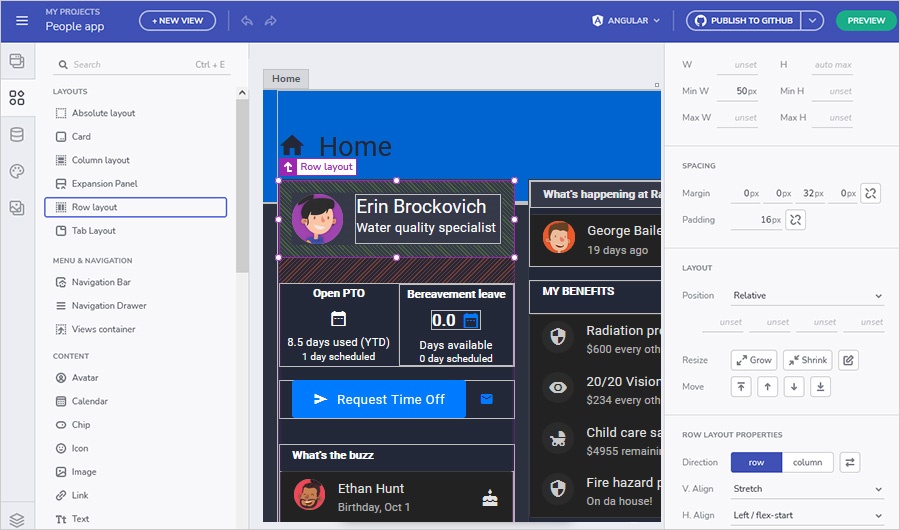The Convergence of Power and Simplicity in Enterprise Development
The software development landscape is in a constant state of evolution, driven by the relentless demand for faster delivery and greater business agility. In recent years, low-code/no-code (LCNC) platforms have surged in popularity, promising to democratize application development and empower “citizen developers.” However, a fascinating and powerful trend is emerging from this movement: the deep integration of robust, professional-grade programming ecosystems with these user-friendly platforms. At the forefront of this convergence is Java, the stalwart of enterprise computing. The latest Java low-code news isn’t about Java being replaced; it’s about Java becoming the high-performance engine that powers the next generation of business applications. This strategic shift is reshaping the perception of Java, moving it from a purely pro-code tool to the foundational layer that provides the security, scalability, and complexity that low-code platforms inherently lack. This article explores this synergy, demonstrating how the mature and expansive Java ecosystem news points towards a future where pro-code and low-code are not competitors, but essential partners.
Section 1: Why Java is the Bedrock for Modern Low-Code Platforms
Low-code platforms excel at creating user interfaces, defining simple workflows, and managing basic data entry. But what happens when you need to execute complex business logic, integrate with a legacy system, or process millions of transactions securely? This is where Java’s strengths become indispensable. The JVM’s legendary stability and performance, a constant theme in JVM news, provides the reliability that enterprises demand. The choice of JVM is also vast, with leading options from OpenJDK news and commercial vendors like Oracle Java news, Azul Zulu news, and Amazon Corretto news, ensuring flexibility in deployment.
Furthermore, the Java ecosystem is built for extensibility. Low-code platforms often require custom components or connectors to communicate with proprietary systems. A professional Java developer can build these components as self-contained, reusable modules. This “pro-code escape hatch” is crucial for handling requirements that fall outside the scope of the visual builder. The core principle is to define a clear contract, often through a Java interface, that the low-code platform can understand and invoke.
Defining a Custom Component with a Java Interface
Imagine a low-code platform needing a custom component to calculate shipping costs based on complex, proprietary business rules. A Java developer would first define an interface that outlines the component’s functionality. This creates a clean separation of concerns and a stable API for the low-code environment.
/**
* Defines the contract for any custom business logic component
* that can be invoked from the low-code platform.
* Implementations of this interface can contain complex,
* pro-code logic that is hidden from the low-code user.
*/
public interface LowCodeCustomComponent {
/**
* Executes the component's business logic.
*
* @param context An object containing input data from the low-code workflow.
* @return A result object to be passed back to the low-code workflow.
*/
ComponentResult execute(ComponentContext context);
}
// Data Transfer Object for input
public class ComponentContext {
private final Map<String, Object> parameters;
public ComponentContext(Map<String, Object> parameters) {
this.parameters = parameters;
}
public <T> T getParameter(String key, Class<T> type) {
return type.cast(parameters.get(key));
}
}
// Data Transfer Object for output
public class ComponentResult {
private final boolean success;
private final Object data;
private final String errorMessage;
// Constructors, getters...
}By implementing this LowCodeCustomComponent interface, a developer can write, test (using tools highlighted in JUnit news and Mockito news), and deploy intricate logic without altering the low-code platform itself. This modular approach is a cornerstone of modern software design and a key reason why Java is a perfect fit for this hybrid model.
Section 2: Exposing Java Business Logic via APIs
The most common and effective way to bridge the gap between a Java backend and a low-code frontend is through a well-defined Application Programming Interface (API), typically a RESTful API. Frameworks like Spring Boot and those within the Jakarta EE news sphere (like JAX-RS) make creating robust, secure, and scalable APIs incredibly efficient. This API-first approach allows the low-code platform to treat the complex Java backend as a black box, simply making HTTP requests to fetch data or trigger actions.
A pro-code team is responsible for defining the data models using tools like the Java Persistence API (JPA) and Hibernate, a topic frequently covered in Hibernate news. They then create API endpoints that allow the low-code application to perform CRUD (Create, Read, Update, Delete) operations on these models. This ensures data integrity, security, and business rule enforcement remain centralized in the Java layer.

Example: Spring Boot REST Controller and JPA Entity
Here’s a practical example using Spring Boot news best practices. We’ll define a `Product` entity and expose it through a simple REST controller. This is a typical task for a Java developer building the backend for a low-code inventory management app.
First, the JPA entity using a Java Record, a feature popularized in Java 17 news, for the corresponding DTO (Data Transfer Object).
import jakarta.persistence.Entity;
import jakarta.persistence.Id;
import jakarta.persistence.GeneratedValue;
import java.math.BigDecimal;
// The JPA Entity representing the 'products' table in the database.
// Pro-code developers manage this layer.
@Entity
public class Product {
@Id
@GeneratedValue
private Long id;
private String sku;
private String name;
private BigDecimal price;
private int stockQuantity;
// Getters and Setters
}
// A DTO (Data Transfer Object) using a Java Record to expose data via the API.
// This decouples the API representation from the database entity.
public record ProductDTO(Long id, String sku, String name, BigDecimal price) {}Next, the Spring `@RestController` that makes this data available to the low-code platform.
import org.springframework.web.bind.annotation.GetMapping;
import org.springframework.web.bind.annotation.PathVariable;
import org.springframework.web.bind.annotation.RequestMapping;
import org.springframework.web.bind.annotation.RestController;
import java.util.List;
import java.util.stream.Collectors;
@RestController
@RequestMapping("/api/products")
public class ProductController {
private final ProductRepository productRepository;
// Constructor injection is a Spring best practice
public ProductController(ProductRepository productRepository) {
this.productRepository = productRepository;
}
@GetMapping
public List<ProductDTO> getAllProducts() {
// Using the Stream API, a key feature since Java 8 news
return productRepository.findAll().stream()
.map(product -> new ProductDTO(product.getId(), product.getSku(), product.getName(), product.getPrice()))
.collect(Collectors.toList());
}
@GetMapping("/{id}")
public ProductDTO getProductById(@PathVariable Long id) {
return productRepository.findById(id)
.map(product -> new ProductDTO(product.getId(), product.getSku(), product.getName(), product.getPrice()))
.orElseThrow(() -> new ProductNotFoundException(id));
}
}
// Assume ProductRepository is a standard Spring Data JPA interface
// public interface ProductRepository extends JpaRepository<Product, Long> {}This clean, versionable API endpoint can now be easily consumed by any low-code tool, allowing a business user to build a product catalog UI without writing a single line of Java.
Section 3: Advanced Integrations and Future-Proofing with Java
The synergy between Java and low-code extends far beyond simple data retrieval. The modern Java ecosystem is buzzing with advancements that enable highly sophisticated backend capabilities, all of which can be surfaced within a low-code environment.
One major area is asynchronous processing. A low-code application might need to kick off a long-running task, like generating a complex report or processing a large file. A Java backend can handle this efficiently using message queues or background job processing libraries like JobRunr news. The latest Java concurrency news, especially around Project Loom news and the introduction of virtual threads in Java 21 news, makes it easier than ever to build highly concurrent systems that can handle tens of thousands of such background tasks with minimal resource overhead. This is a game-changer for the scalability of low-code backends.
Furthermore, the AI revolution is fully embracing Java. The latest Spring AI news and the emergence of libraries like LangChain4j news allow developers to integrate powerful generative AI features into their Java applications. A pro-code developer can build a service that uses these tools to summarize text, answer questions based on a knowledge base, or generate images. This service is then exposed via an API, allowing a low-code developer to add an “AI Assistant” to their application with a simple button click.
Example: Data Processing with Java Streams
Let’s enhance our `ProductService` to perform a more complex, server-side filtering operation. This kind of logic is far more efficient to execute in Java than in a typical low-code environment, especially with large datasets. This demonstrates how business logic is best kept in the pro-code layer.
import org.springframework.stereotype.Service;
import java.math.BigDecimal;
import java.util.List;
import java.util.stream.Collectors;
@Service
public class ProductService {
private final ProductRepository productRepository;
public ProductService(ProductRepository productRepository) {
this.productRepository = productRepository;
}
/**
* Finds premium products that are currently in stock.
* This business logic (what defines "premium") is encapsulated
* here in the pro-code layer.
*
* @param priceThreshold The minimum price to be considered premium.
* @return A list of premium, in-stock product DTOs.
*/
public List<ProductDTO> findInStockPremiumProducts(BigDecimal priceThreshold) {
List<Product> allProducts = productRepository.findAll();
// The Stream API provides a fluent, declarative way to process data
return allProducts.stream()
.filter(product -> product.getStockQuantity() > 0) // Check if in stock
.filter(product -> product.getPrice().compareTo(priceThreshold) >= 0) // Check if premium
.map(product -> new ProductDTO(product.getId(), product.getSku(), product.getName(), product.getPrice()))
.collect(Collectors.toList());
}
}This service method can be called from the controller, exposing a powerful, pre-processed data source to the low-code platform, improving both performance and maintainability.

Section 4: Best Practices for a Hybrid Development World
Successfully operating in a hybrid low-code/pro-code environment requires discipline and clear guidelines. Following these best practices, which are part of the collective Java wisdom tips news, can prevent architectural issues and ensure a smooth workflow.
Establish Clear Boundaries
The most critical rule is to define what belongs in each layer.
- Pro-Code (Java): Core business logic, complex algorithms, integrations with external systems, security enforcement, and data persistence.
- Low-Code: User interface (UI) design, simple page-to-page navigation, data visualization, and triggering workflows defined in the Java backend.
Design Immutable API Contracts
The API is the glue holding the system together. Treat it as a public contract. Use API versioning (e.g., `/api/v1/products`) from the start. Avoid making breaking changes to an existing API version, as this could instantly disable functionality in multiple low-code applications that depend on it. This is a key aspect of good governance in the Java SE news and enterprise world.

Centralize Security in Java
Never trust the client. All authentication, authorization, and data validation must be rigorously enforced in the Java backend. The low-code frontend should be treated as an untrusted environment. Leverage mature, battle-tested frameworks like Spring Security to handle these critical aspects, a constant theme in Java security news.
Prioritize Performance and Monitoring
As the low-code platform grows, the Java services behind it will come under increasing load. Proactively monitor your APIs for performance bottlenecks. The latest Java performance news often highlights tools and techniques for profiling and optimizing JVM applications. Features like Java virtual threads news can significantly improve throughput, but they are not a silver bullet; proper monitoring is still essential.
Conclusion: A New Chapter for Java Development
The narrative that low-code platforms will make professional developers obsolete is fundamentally flawed. Instead, we are witnessing a powerful synthesis where low-code handles the “what” (the user-facing application) while Java’s pro-code ecosystem masterfully handles the “how” (the complex, secure, and scalable implementation). This fusion accelerates development cycles, empowers business users to build what they need, and frees up professional Java developers to focus on high-value problems that truly require their expertise.
For developers, this is not a threat but an opportunity. By mastering API design, embracing modern Java features from Java 11 news to Java 21, and understanding how to build services for a low-code world, you position yourself at the center of the next wave of enterprise application development. The ongoing Java low-code news confirms that Java’s role is not diminishing; it’s evolving into the indispensable, high-performance foundation for the future of business software.

